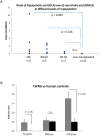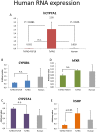Mice with chimeric livers are an improved model for human lipoprotein metabolism
- PMID: 24223822
- PMCID: PMC3817217
- DOI: 10.1371/journal.pone.0078550
Mice with chimeric livers are an improved model for human lipoprotein metabolism
Erratum in
- PLoS One. 2014;9(7):e103870. Nauglers, Scott [corrected to Naugler, Willscott Edward]
Abstract
Objective: Rodents are poor model for human hyperlipidemias because total cholesterol and low density lipoprotein levels are very low on a normal diet. Lipoprotein metabolism is primarily regulated by hepatocytes and we therefore assessed whether chimeric mice extensively repopulated with human cells can model human lipid and bile acid metabolism.
Design: FRG [ F ah(-/-) R ag2(-/-)Il2r g (-/-)]) mice were repopulated with primary human hepatocytes. Serum lipoprotein lipid composition and distribution (VLDL, LDL, and HDL) was analyzed by size exclusion chromatography. Bile was analyzed by LC-MS or by GC-MS. RNA expression levels were measured by quantitative RT-PCR.
Results: Chimeric mice displayed increased LDL and VLDL fractions and a lower HDL fraction compared to wild type, thus significantly shifting the ratio of LDL/HDL towards a human profile. Bile acid analysis revealed a human-like pattern with high amounts of cholic acid and deoxycholic acid (DCA). Control mice had only taurine-conjugated bile acids as expcted, but highly repopulated mice had glycine-conjugated cholic acid as found in human bile. RNA levels of human genes involved in bile acid synthesis including CYP7A1, and CYP27A1 were significantly upregulated as compared to human control liver. However, administration of recombinant hFGF19 restored human CYP7A1 levels to normal.
Conclusion: Humanized-liver mice showed a typical human lipoprotein profile with LDL as the predominant lipoprotein fraction even on a normal diet. The bile acid profile confirmed presence of an intact enterohepatic circulation. Although bile acid synthesis was deregulated in this model, this could be fully normalized by FGF19 administration. Taken together these data indicate that chimeric FRG-mice are a useful new model for human lipoprotein and bile-acid metabolism.
Conflict of interest statement
Figures




Similar articles
-
Downregulation of Cyp7a1 by Cholic Acid and Chenodeoxycholic Acid in Cyp27a1/ApoE Double Knockout Mice: Differential Cardiovascular Outcome.Front Endocrinol (Lausanne). 2020 Oct 28;11:586980. doi: 10.3389/fendo.2020.586980. eCollection 2020. Front Endocrinol (Lausanne). 2020. PMID: 33193099 Free PMC article.
-
Medium-chain fatty acids reduce serum cholesterol by regulating the metabolism of bile acid in C57BL/6J mice.Food Funct. 2017 Jan 25;8(1):291-298. doi: 10.1039/c6fo01207h. Food Funct. 2017. PMID: 28009872
-
The effect of ursodeoxycholic acid on the relative expression of the lipid metabolism genes in mouse cholesterol gallstone models.Lipids Health Dis. 2020 Jul 2;19(1):158. doi: 10.1186/s12944-020-01334-3. Lipids Health Dis. 2020. PMID: 32615989 Free PMC article.
-
Effects of therapeutically approved individual bile acids on the development of metabolic dysfunction-associated steatohepatitis a low bile acid mouse model.Toxicol Sci. 2024 Dec 1;202(2):179-195. doi: 10.1093/toxsci/kfae110. Toxicol Sci. 2024. PMID: 39302723 Free PMC article.
-
Cytochrome P450s in the synthesis of cholesterol and bile acids--from mouse models to human diseases.FEBS J. 2012 May;279(9):1516-33. doi: 10.1111/j.1742-4658.2011.08432.x. Epub 2011 Dec 22. FEBS J. 2012. PMID: 22111624 Review.
Cited by
-
The major urinary protein gene cluster knockout mouse as a novel model for translational metabolism research.Sci Rep. 2022 Aug 1;12(1):13161. doi: 10.1038/s41598-022-17195-y. Sci Rep. 2022. PMID: 35915220 Free PMC article.
-
Functional and Biochemical Characterization of Hepatitis C Virus (HCV) Particles Produced in a Humanized Liver Mouse Model.J Biol Chem. 2015 Sep 18;290(38):23173-87. doi: 10.1074/jbc.M115.662999. Epub 2015 Jul 29. J Biol Chem. 2015. PMID: 26224633 Free PMC article.
-
Generation of Human Liver Chimeric Mice and Harvesting of Human Hepatocytes from Mouse Livers.Methods Mol Biol. 2022;2429:379-390. doi: 10.1007/978-1-0716-1979-7_25. Methods Mol Biol. 2022. PMID: 35507175
-
Behavioral and cognitive performance of humanized APOEε3/ε3 liver mice in relation to plasma apolipoprotein E levels.Sci Rep. 2023 Jan 31;13(1):1728. doi: 10.1038/s41598-023-28165-3. Sci Rep. 2023. PMID: 36720957 Free PMC article.
-
FXR activation by obeticholic acid or nonsteroidal agonists induces a human-like lipoprotein cholesterol change in mice with humanized chimeric liver.J Lipid Res. 2018 Jun;59(6):982-993. doi: 10.1194/jlr.M081935. Epub 2018 Mar 20. J Lipid Res. 2018. PMID: 29559521 Free PMC article.
References
-
- Society TR (2004) The Use of non-human animals in research: a guide for scientists. The royal society.
-
- Kamimura H, Nakada N, Suzuki K, Mera A, Souda K, et al. (2011) Assessment of chimeric mice with humanized liver as a tool for predicting circulating human metabolites. Drug Metab Pharmacokinet 25: 223–235. - PubMed
-
- Shultz LD, Ishikawa F, Greiner DL (2007) Humanized mice in translational biomedical research. Nat Rev Immunol 7: 118–130. - PubMed
-
- Katoh M, Tateno C, Yoshizato K, Yokoi T (2008) Chimeric mice with humanized liver. Toxicology 246: 9–17. - PubMed
Publication types
MeSH terms
Substances
Grants and funding
LinkOut - more resources
Full Text Sources
Other Literature Sources
Molecular Biology Databases
Miscellaneous

